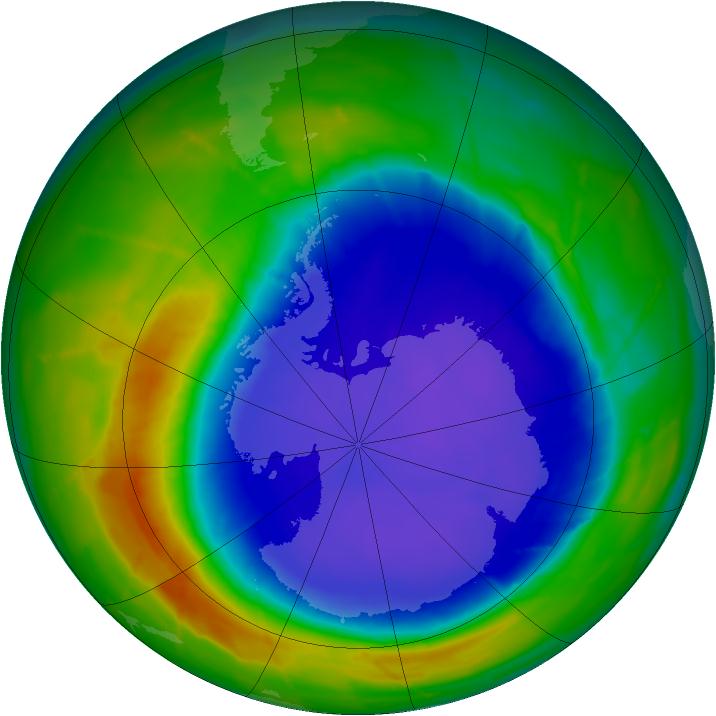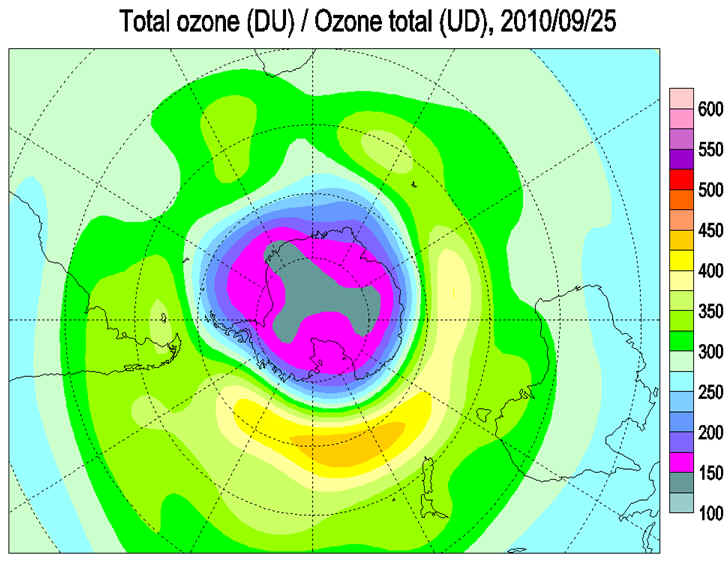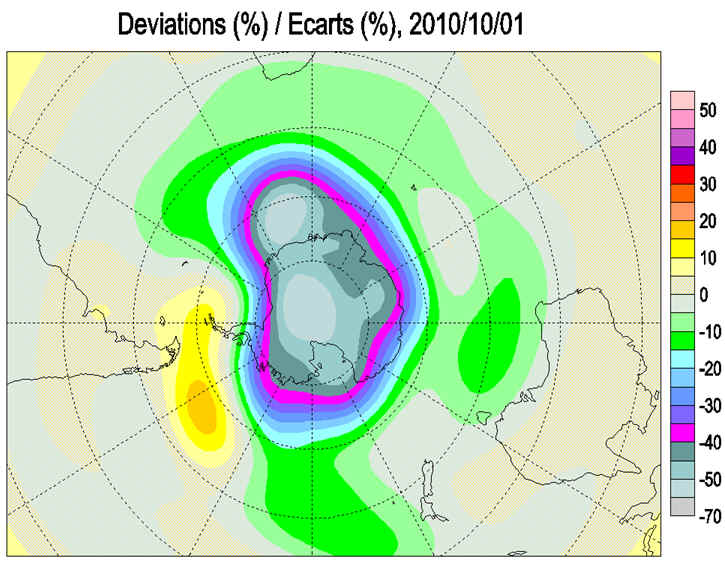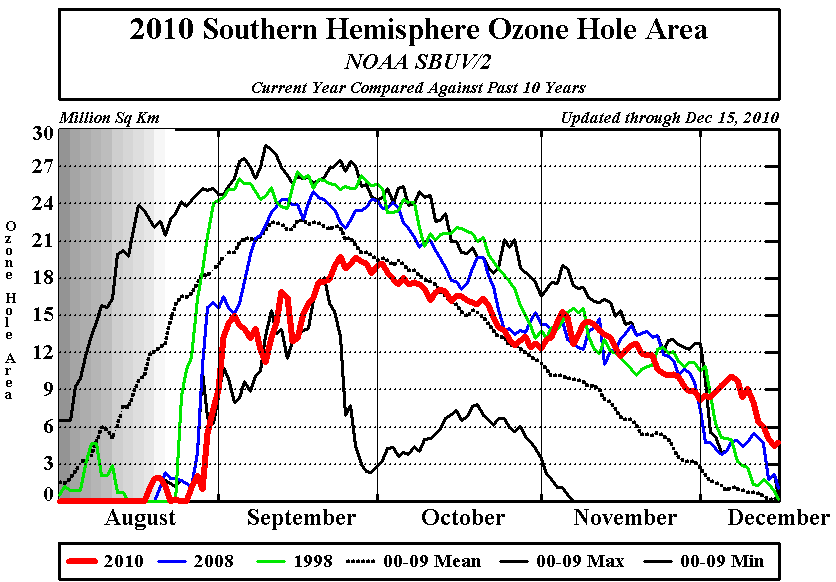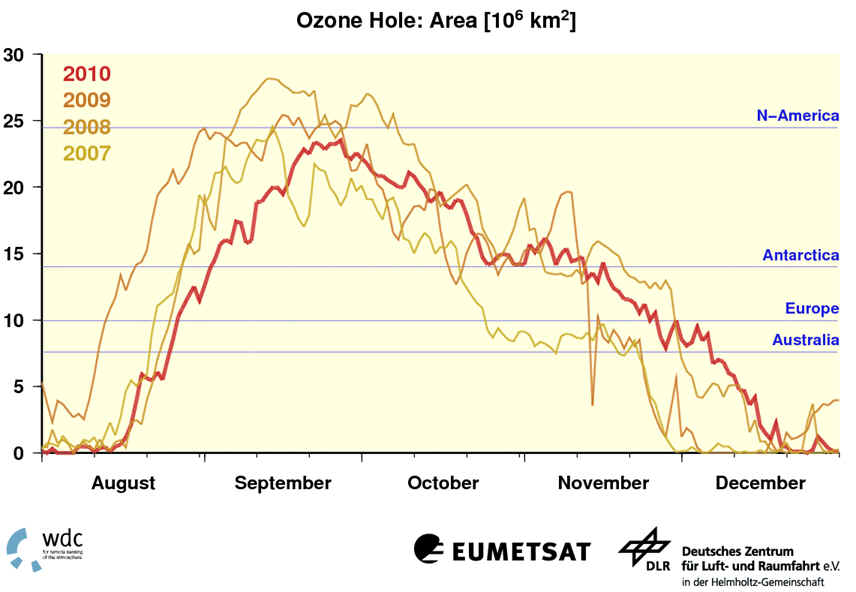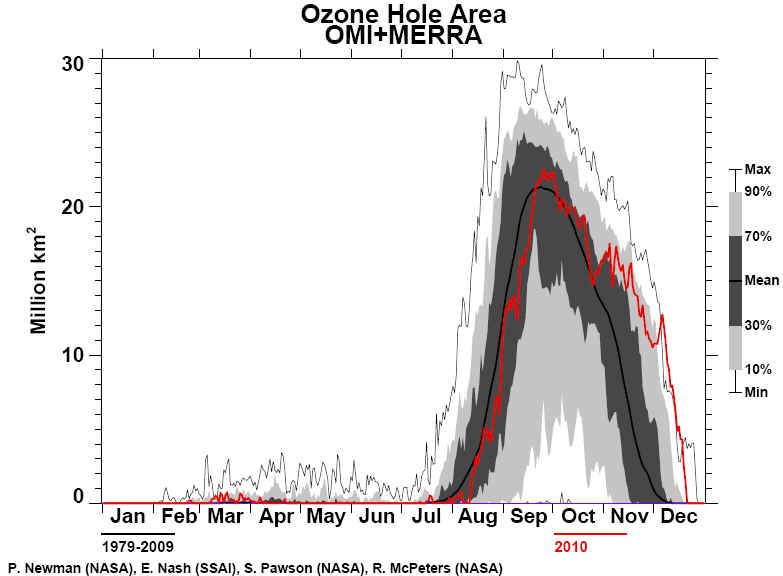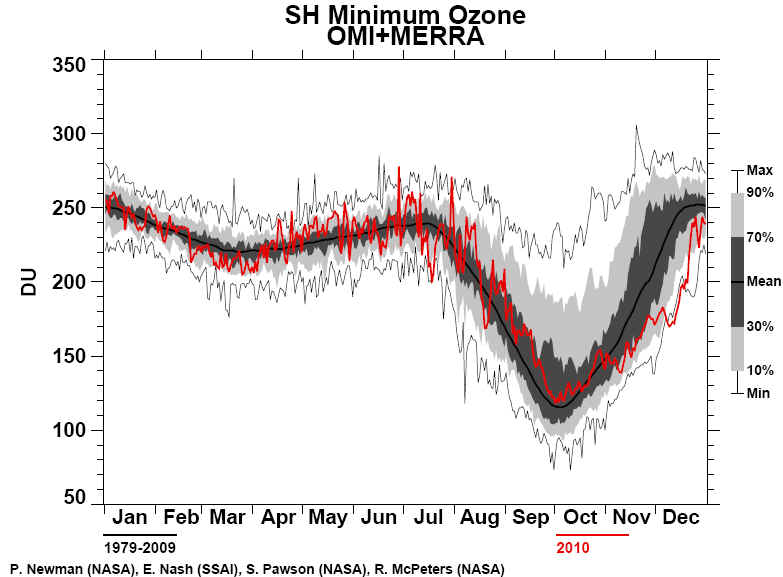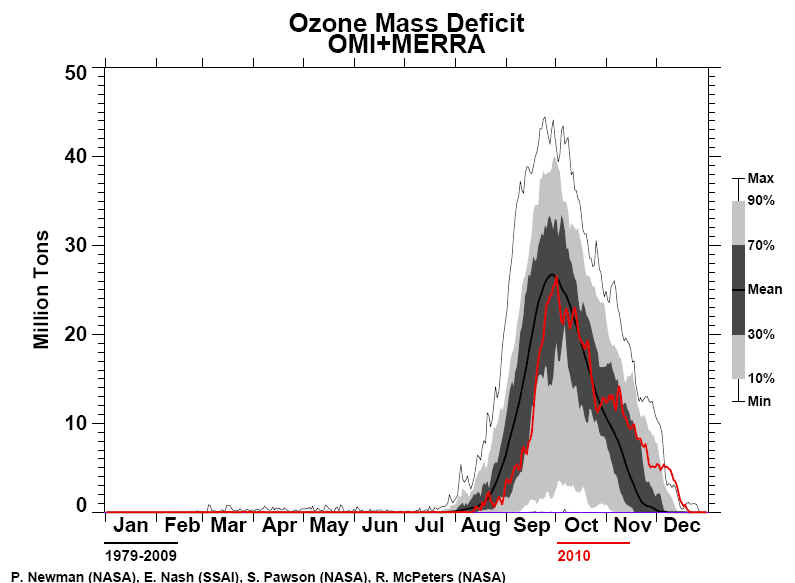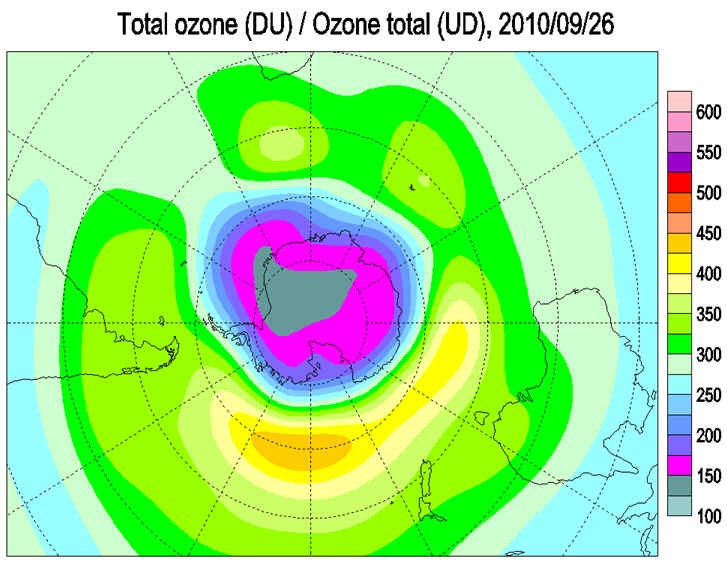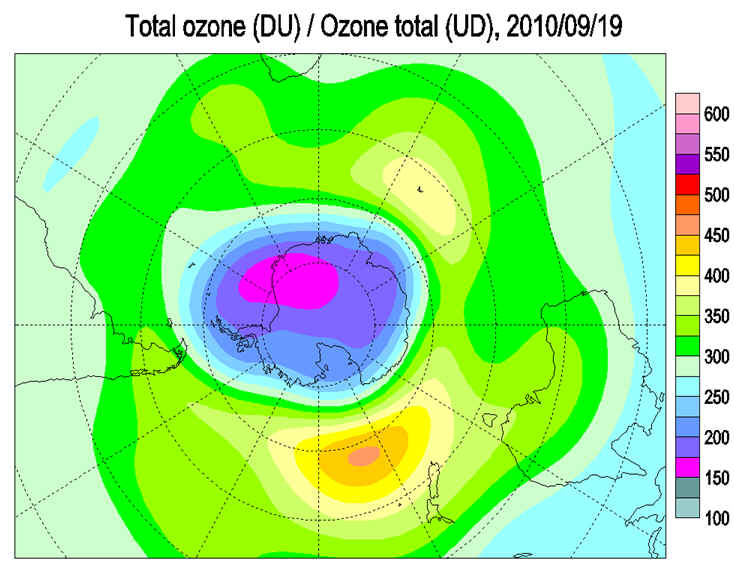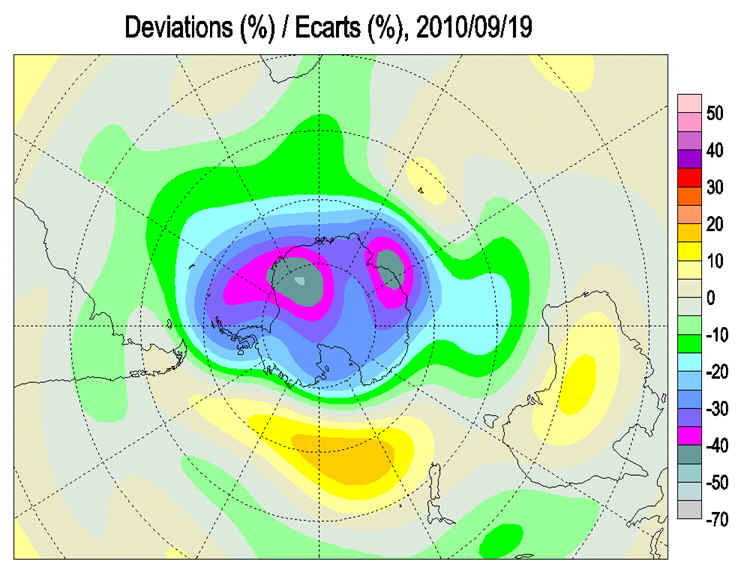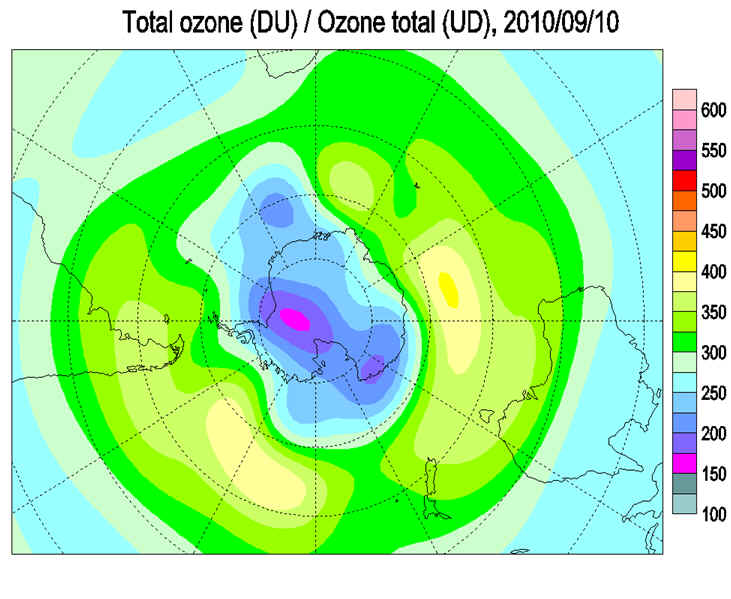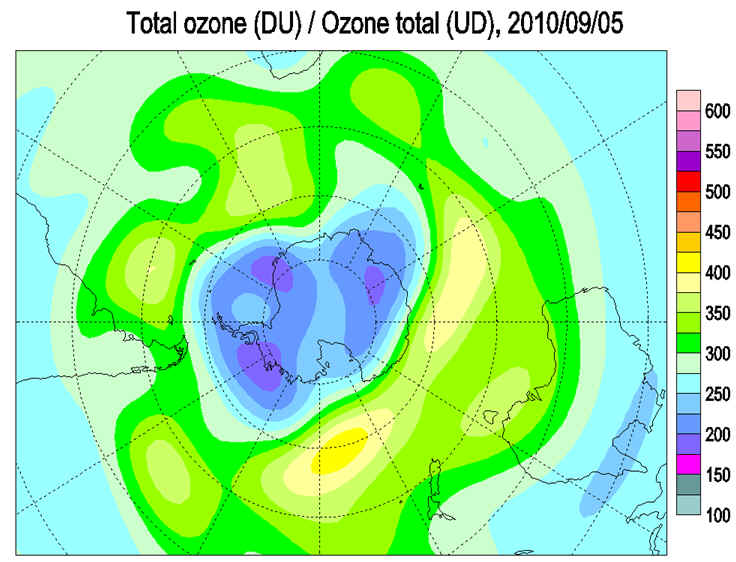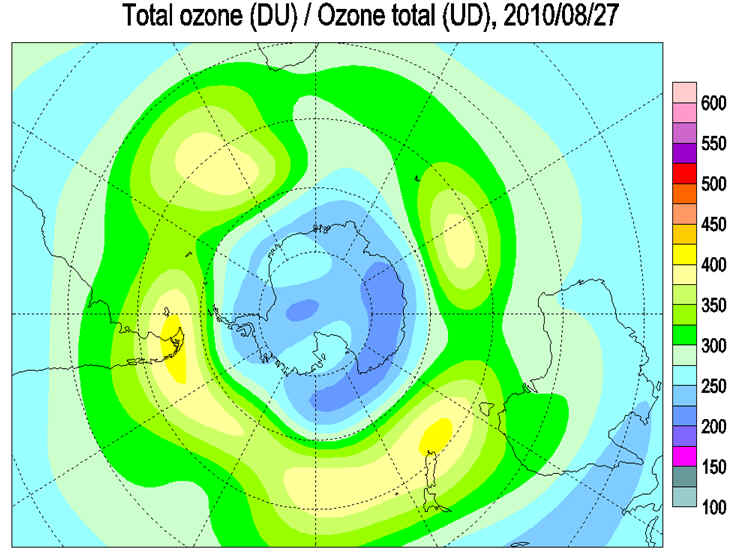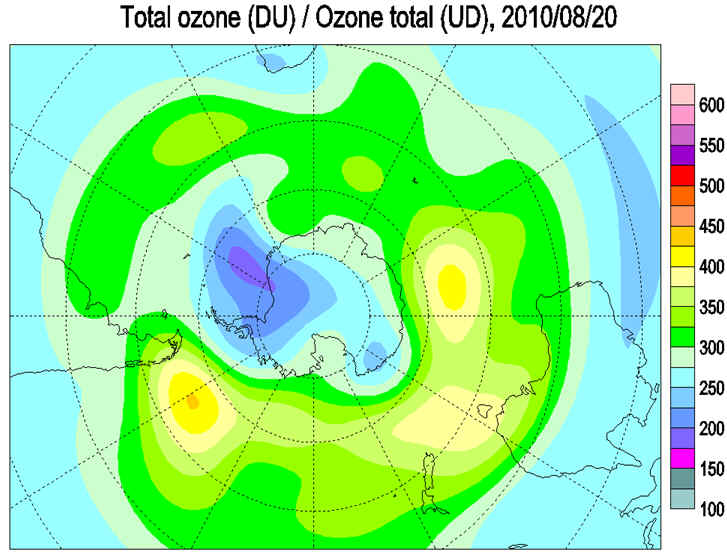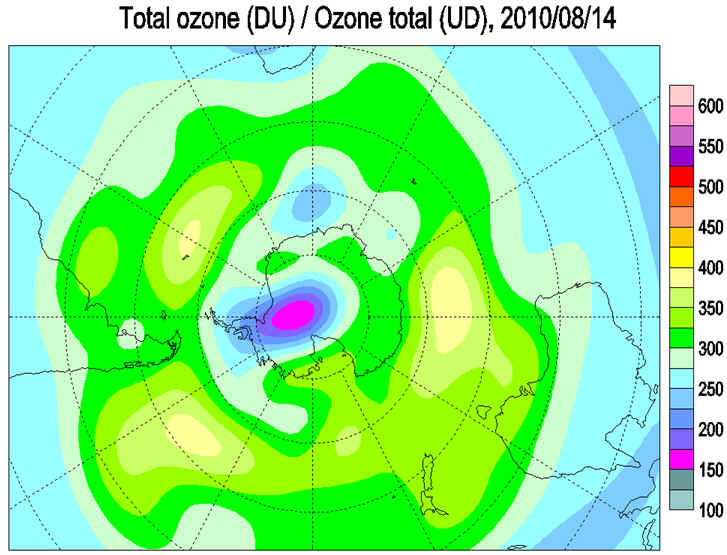The Ozone Hole 2010
http://ozonewatch.gsfc.nasa.gov The Ozone Hole of 2010 was the second smallest in over a decade. It reached it's largest size of 22.6 million square kilometers on September 25,2010 which is below the decade average of 25.7 million square kilometers.
Ozone values reached the lowest point at 118 Dobson Units on October 1, 2010 .
The year-to-year variation in the size of the ozone hole is mainly related to the weather conditions in the polar stratosphere. The warmer conditions that prevailed over Antarctica in the winter of 2010 resulted in a smaller ozone hole as compared to previous years.
http://www.cpc.ncep.noaa.gov/products/stratosphere/polar/gif_files/ozone_hole_plot.png
http://wdc.dlr.de/data_products/SERVICES/O3_SH/o3hole_southpole.php
MACC - Monitoring Atmospheric Composition and Climate-The destruction of ozone in the ozone layer over Antarctica this year is about 40 to 60% less compared to the previous five years, according to MACC analyses based on observations from the SCIAMACHY instrument on board the European ENVISAT satellite. Less ozone destruction is consistent with the expectation that the ozone layer will recover during the coming decades due to reduction in the stratospheric amount of chlorine. However, such a large change cannot be attributed to the slow decrease of stratospheric chlorine of 0.5-1% per year. This year’s reduced ozone destruction turns out to be caused by unusual meteorological conditions. Sudden Stratospheric Warming Effect of nitrogen-oxides on
chlorine release Although the temperature in the
Antarctic stratosphere sinks below -78°C every July and August, it does not get
much colder. A small temperature rise of only a few degrees thus can result in
considerably more nitrogen-oxides remaining in the stratosphere, and thus less
effective ozone destruction. Recent measurements of the American MLS instrument
on the AURA satellite indeed show that there are still nitrogen-oxides present
in the stratosphere above Antarctica, unlike previous years. Late onset of ozone desctruction
in 2010 Not the first time Situation at 2010 December 10British Antarctic Survey Ozone BulletinOzone values over parts of the Antarctic Peninsula fell rapidly rapidly to around 240 DU in the first half of July, but then recovered. By early August the ozone hole had begun to form, though it was a slow start to the season and significant depletion did not commence until towards the end of the month. Ozone values at Rothera fell below the ozone hole threshold for the first time on August 17, but then recovered. The ozone hole was at its largest in late September at around 20 million square kilometres, which was well below the average size of the last decade. This slow start and relatively shallow ozone hole was linked to warmer than usual stratospheric temperatures reducing the volume of stratospheric clouds early in the season. Since its peak the ozone hole has slowly declined in area and is now around 10 million square kilometres, which is a record size for this time of year. The ozone hole has been slowly filling, with lowest ozone values now around 190 DU, broadly over the pole. Filling is expected to proceed more rapidly over the coming week with levels rising above 220 DU. In the belt surrounding Antarctica outside the polar vortex ozone, values are slowly declining from their peak of a little above 400 DU. The polar vortex has passed its largest area, which was slightly above the average area of the last decade and at 70hPa remains much larger than the average for this time of year and is near record in size. The temperature of the ozone layer within it was at the winter minimum in August but is rising, with stratospheric temperatures now higher than the PSC formation threshold, albeit rising more slowly than usual. The fringes of the ozone hole extended over the tip of South America and South Georgia over September 6 - 9, 16 - 21, October 10 - 12 and18 - 23. Situation at 2010 November 5British Antarctic Survey Ozone BulletinOzone values over parts of the Antarctic Peninsula fell rapidly rapidly to around 240 DU in the first half of July, but then recovered. By early August the ozone hole had begun to form, though it was a slow start to the season and significant depletion did not commence until towards the end of the month. Ozone values at Rothera fell below the ozone hole threshold for the first time on August 17, but then recovered. The ozone hole was at its largest in late September at around 20 million square kilometres, which was well below the average size of the last decade. It has now shrunk to around 12 million square kilometres, a little larger than the average for this time of year over the last decade. Lowest ozone values are centred over the Pensacola Mountains. In the belt surrounding Antarctica outside the polar vortex ozone, values are slowly declining from their peak of a little above 400 DU. The polar vortex has passed its largest area, which was slightly above the average area of the last decade and at 70hPa remains a little larger than the average for this time of year. The temperature of the ozone layer within it has passed the late winter minimum and is slowly rising. Above 50 hPa temperatures are higher than the PSC threshold and the volume capable of forming polar stratospheric clouds (PSCs) is now very small. The fringes of the ozone hole extended over the tip of South America and South Georgia over September 6 - 9, 16 - 21, October 10 - 12 and18 - 23. Situation at 2010 October 25British Antarctic Survey Ozone BulletinOzone values over parts of the Antarctic Peninsula fell rapidly rapidly to around 240 DU in the first half of July, but then recovered. By early August the ozone hole had begun to form, though it was a slow start to the season and significant depletion did not commence until towards the end of the month. Ozone values at Rothera fell below the ozone hole threshold for the first time on August 17, but then recovered. The ozone hole was at its largest in late September at around 20 million square kilometers, which was well below the average size of the last decade. It has now shrunk to around 17 million square kilometers, a little larger than the average for this time of year over the last decade. Lowest ozone values are centred over Dronning Maud Land. In the belt surrounding Antarctica outside the polar vortex ozone, values are slowly declining from their peak of a little above 400 DU. The polar vortex has passed its largest area, which was slightly above the average area of the last decade and at 70hPa remains a little larger than the average for this time of year. The temperature of the ozone layer within it has passed the late winter minimum and is slowly rising. Above 50 hPa temperatures are higher than the PSC threshold and the volume capable of forming polar stratospheric clouds (PSCs) is now very small. The fringes of the ozone hole extended over the tip of South America and South Georgia over September 6 - 9, 16 - 21, October 10 - 12 and18 - 23. Situation at 2010 October 8British Antarctic Survey Ozone BulletinOzone values over parts of the Antarctic Peninsula fell rapidly rapidly to around 240 DU in the first half of July, but then recovered. By early August the ozone hole had begun to form, though it was a slow start to the season and significant depletion did not commence until towards the end of the month. Ozone values at Rothera fell below the ozone hole threshold for the first time on August 17, but then recovered. The ozone hole was at its largest in late September at around 20 million square kilometres, which was well below the average size of the last decade. It has now shrunk to around 18 million square kilometres. Lowest ozone values are slightly offset from the South Pole towards the Atlantic sector and overall values are near their lowest. The fringes of the ozone hole extended over the tip of South America and South Georgia over September 6 - 9 and again from 16 - 21. In the belt outside the polar vortex surrounding Antarctica ozone values are near their highest, with some areas above 400 DU. On a few occasions the polar vortex has moved sufficiently towards the Atlantic sector to allow these high ozone areas to move over the continental fringes of the Pacific sector. The polar vortex has passed its largest area, which was slightly above the average area of the last decade and at 70hPa remains a little larger than the average for this time of year . The temperature of the ozone layer within it has passed the late winter minimum, with the area capable of forming polar stratospheric clouds (PSCs) now near the average of the last decade. Polar stratospheric clouds are however still widespread. Situation at 2010 October 1British Antarctic Survey Ozone BulletinOzone values over parts of the Antarctic Peninsula fell rapidly rapidly to around 240 DU in the first half of July, but then recovered. By early August the ozone hole had begun to form, though it was a slow start to the season. Ozone values at Rothera fell below the ozone hole threshold for the first time on August 17, but then recovered. The ozone hole is now near its largest, but at an estimated 19 million square kilometres it is below the average size of the last decade. Lowest ozone values are broadly centred on the South Pole and overall values are nearing their lowest. The fringes of the ozone hole extended over the tip of South America and South Georgia over September 6 - 9 and again from 16 - 21. In the belt outside the polar vortex surrounding Antarctica ozone values are near their highest, with some areas above 400 DU. On a few occasions the polar vortex has moved sufficiently towards the Atlantic sector to allow these high ozone areas to move over the continental fringes of the Pacific sector. The polar vortex has passed its largest area, which was slightly above the average area of the last decade and is now close to the average for this time of year at 70hPa. The temperature of the ozone layer within it has passed the late winter minimum, with the area capable of forming polar stratospheric clouds (PSCs) smaller than the average of the last decade. Polar stratospheric clouds are however widespread.
Situation at 2010 September 24British Antarctic Survey Ozone BulletinOzone values over parts of the Antarctic Peninsula fell rapidly rapidly to around 240 DU in the first half of July, but then recovered. By early August the ozone hole had begun to form, though it was a slow start to the season. Ozone values at Rothera fell below the ozone hole threshold for the first time on August 17, but then recovered. Low ozone values are currently seen over a wide swathe of the continent. An increasing area is below the ozone hole threshold, but at an estimated 19 million square kilometres it is well below the average size of the last decade. The fringes of the ozone hole extended over the tip of South America and South Georgia over September 6 - 9 and again from 16 - 21. Around Antarctica ozone values are near their highest, with some areas above 400 DU. On a few occasions the polar vortex has moved sufficiently towards the Atlantic sector to allow these high ozone areas to move over the continental fringes of the Pacific sector. The polar vortex has passed its largest area, which was slightly above the average area of the last decade and is now close to the average for this time of year. The temperature of the ozone layer within it has passed the late winter minimum, with the area capable of forming polar stratospheric clouds (PSCs) smaller than the average of the last decade. Polar stratospheric clouds are however widespread.
Situation at 2010 September 10British Antarctic Survey Ozone BulletinOzone values over parts of the Antarctic Peninsula fell rapidly rapidly to around 240 DU in the first half of July, but then recovered. By early August the ozone hole had begun to form. Ozone values at Rothera fell below the ozone hole threshold for the first time on August 17, but then recovered. Lowest ozone values are currently seen in a wide ellipse across Antarctica extending into the Weddell Sea. An increasing area is below the ozone hole threshold, but at an estimated 14 million square kilometres it is substantially below the average of the last decade. The fringes of the ozone hole have extended over the tip of South America and South Georgia in the last few days. Around Antarctica ozone values are building, with some areas above 400 DU. On a few occasions the polar vortex has moved sufficiently towards the Atlantic sector to allow these high ozone areas to move over the continental fringes of the Pacific sector. The polar vortex appears to have passed its largest area, which was slightly above the average area of the last decade but is now smaller than the average for this time of year. The temperature of the ozone layer within it is nearing the late winter minimum, but the area capable of forming polar stratospheric clouds (PSCs) is smaller than the average of the last decade. Polar stratospheric clouds are however widespread.
Situation at 2010 September 2British Antarctic Survey Ozone BulletinOzone values over parts of the Antarctic Peninsula fell rapidly rapidly to around 240 DU in the first half of July, but then recovered. By early August the ozone hole had begun to form. Ozone values at Rothera fell below the ozone hole threshold for the first time on August 17, but then recovered. Lowest ozone values are currently seen over Terre Adelie, where they are near the ozone hole threshold. Elsewhere over Antarctica ozone values are generally below 270 DU. Around Antarctica ozone values are building, with some areas above 400 DU. On a few occasions the polar vortex has moved sufficiently towards the Atlantic sector to allow these high ozone areas to move over the continental fringes of the Pacific sector. The polar vortex appears to have passed its largest area, which was slightly above the average area of the last decade but is now smaller than the average for this time of year. The temperature of the ozone layer within it is nearing the late winter minimum, but the area capable of forming polar stratospheric clouds (PSCs) is smaller than the average of the last decade. Polar stratospheric clouds are however widespread.
Situation at 2010 August 20British Antarctic Survey Ozone BulletinOzone values over parts of the Antarctic Peninsula fell rapidly rapidly to around 240 DU in the first half of July, but then recovered. By early August the ozone hole had begun to form. Ozone values at Rothera fell below the ozone hole threshold for the first time on August 17. Lowest ozone values are currently seen over the base of the Antarctic Peninsula. Elsewhere over Antarctica ozone values are generally above 250 DU. Around Antarctica ozone values are building, with some areas above 400 DU. On a few occasions the polar vortex has moved sufficiently towards the Atlantic sector to allow these high ozone areas to move over the continental fringes of the Pacific sector. The polar vortex is near its largest and slightly above the average area of the last decade. The temperature of the ozone layer within it is nearing the late winter minimum, but the area capable of forming polar stratospheric clouds (PSCs) is smaller than the average of the last decade. Polar stratospheric clouds are however widespread.
|
||||||||||||||||||||||||

